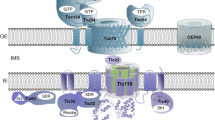Abstract
Protein import into chloroplasts requires a transit peptide, which interacts with the chloroplast transport apparatus and leads to translocation of the protein across the chloroplast envelope. While the amino acid sequences of many transit peptides are known, functional domains have been difficult to identify. Previous studies suggest that the carboxyl terminus of the transit peptide for ribulose bisphosphate carboxylase small subunit is important for both translocation across the chloroplast envelope and proper processing of the precursor protein. We dissected this region using in vitro mutagenesis, creating a set of mutants with small changes in primary structure predicted to cause alterations in secondary structure. The import behavior of the mutant proteins was assessed using isolated chloroplasts. Our results show that removal of a conserved arginine residue in this region results in impaired processing, but does not necessarily affect import rates. In contrast, substituting amino acids with low reverse turn or amphiphilic potential for other original residues affected import rate but not processing.
Similar content being viewed by others
References
Bauerle, C, Keegstra, K: Kinetic analysis of the transport of thylakoid lumenal proteins in experiments using intact chloroplasts. J Biol Chem 266: 5876–5883 (1991).
Birnboim, HC, Doly, J: Rapid alkaline extraction procedure for screening recombinant plasmid DNA. Nucl Acids Res 7: 1513–1523 (1979).
Chou, PY, Fasman, GD: Prediction of the secondary structure of proteins from their amino acid sequence. Adv Enzymol 47: 45–147 (1978).
Clark, SE, Lamppa, GK: Determinants for cleavage of the chlorophyll a/b binding protein precursor: a requirement for a basic residue that is not universal for chloroplast imported proteins. J Cell Biol 114: 681–688 (1991).
Cline, K, Werner-Washburne, M, Lubben, T, Keegstra, K: Precursors to two nuclear-encoded chloroplast proteins bind to the outer envelope membrane before being imported into chloroplasts. J Biol Chem 260: 3691–3695 (1985).
Devereux, J, Haeberli, P, Smithies, O: A comprehensive set of sequence-analysis programs for the VAX. Nucl Acids Res 12: 387–395 (1984).
Eisenberg, D, Weiss, RM, Terwilliger, TC: The hydrophobic moment detects periodicity in protein hydrophobicity. Proc Natl Acad Sci USA 81: 140–144 (1984).
Gavel, Y, vonHeijne, G: A conserved cleavage-site motif in chloroplast transit peptides. FEBS Lett 261: 455–458 (1990).
Karlin-Neumann, GA, Tobin, EM: Transit-peptides of nuclear-encoded chloroplast proteins share a common amino-acid framework. EMBO J 8: 9–14 (1986).
Keegstra, K, Olsen, LJ, Theg, SM: Chloroplastic precursors and their transport across the envelope membranes. Annu Rev Plant Physiol Plant Mol Biol 40: 471–501 (1989).
Laemmli, UK: Cleavage of structural proteins during the assembly of the head of bacteriophage T4. Nature 227: 680–685 (1970).
Li, HM, Moore, T, Keegstra, K: Targeting of proteins to outer envelope membrane uses a different pathway than transport into chloroplasts. Plant Cell 3: 709–717 (1991).
Lubben, T, Keegstra, K: Efficient in vitro import of a cytosolic heat-shock protein into pea chloroplasts. Proc Natl Acad Sci USA 83: 5502–5506 (1986).
Maniatis, T, Fritsch, EF, Sambrook, J: Molecular Cloning: A Laboratory Manual. Cold Spring Harbor Laboratory, Cold Spring Harbor, NY (1982).
Ostrem, JA, Ramage, RT, Bohnert, HJ, Wasmann, CC: Deletion of the carboxyl-terminal portion of the transit peptide affects processing but not import or assembly of the small subunit of ribulose-1,5-bisphosphate carboxylase. J Biol Chem 264: 3662–3665 (1989).
Perry, SE, Buvinger, WE, Bennet, J, Keegstra, K: Synthetic analogues of a transit peptide inhibit binding or translocation of chloroplastic precursor proteins. J Biol Chem 266: 11882–11889 (1991).
Reiss, B, Wasmann, CC, Schell, J, Bohnert, HJ: Effect of mutations on the binding and translocation functions of a chloroplast transit peptide. Proc Natl Acad Sci USA 86: 886–890 (1990).
Sanger, F, Miklin, S, Coulson, AR: DNA sequencing with chain-terminating inhibitors. Proc Natl Acad Sci USA 74: 5463–5467 (1977).
Schmidt, GW, Mishkind, ML: Rapid degradation of unassembled ribulose-1,5-bisphosphate carboxylase subunits in chloroplasts. Proc Natl Acad Sci USA 80: 2632–2636 (1983).
Smeekens, S, Geerts, D, Bauerle, C, Weisbeek, P: Essential function in chloroplast recognition of the ferredoxin transit peptide processing region. Mol Gen Genet 216: 178–182 (1989).
vonHeijne, G, Steppuhn, J, Herrmann, RG: Domain-structure of mitochondrial and chloroplast targeting peptides. Eur J Biochem 180: 535–545 (1989).
Wasmann, CC, Reiss, B, Bohnert, HJ: Complete processing of a small subunit of ribulose-1,5-bisphosphate carboxylase oxygenase from pea requires the amino-acid sequence ile-thr-ser. J Biol Chem 263: 617–619 (1988).
Author information
Authors and Affiliations
Rights and permissions
About this article
Cite this article
Archer, E.K., Keegstra, K. Analysis of chloroplast transit peptide function using mutations in the carboxyl-terminal region. Plant Mol Biol 23, 1105–1115 (1993). https://doi.org/10.1007/BF00042345
Received:
Accepted:
Issue Date:
DOI: https://doi.org/10.1007/BF00042345




